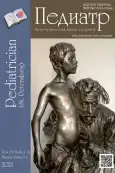Исходный вегетативный тонус при легком течении атопической бронхиальной астмы у детей
- Авторы: Буряк В.Н.1, Антонова Т.И.2, Дудко М.В.2, Малышева И.В.2, Шепеленко К.К.2
-
Учреждения:
- Федеральное государственное бюджетное образовательное учреждение высшего образования «Северо-Западный государственный медицинский университет имени И.И. Мечникова» Министерства здравоохранения Российской Федерации
- Санкт-Петербургское государственное бюджетное учреждение здравоохранения «Детская городская поликлиника № 35» Московского района
- Выпуск: Том 12, № 2 (2021)
- Страницы: 13-18
- Раздел: Оригинальные статьи
- URL: https://ogarev-online.ru/pediatr/article/view/76454
- DOI: https://doi.org/10.17816/PED12213-18
- ID: 76454
Цитировать
Аннотация
Введение. В большинстве индустриально развитых стран аллергические заболевания поражают до 20 % населения. Данная патология принадлежит к наиболее распространенной у детей: по данным Всемирной организации здраво-охранения ей страдает более 15 % детского населения Земли. За последние годы отмечается значительный рост частоты и более тяжелое течение данных болезней, в связи с чем они рассматриваются в современном обществе как крупная медицинская и социальная проблема. Так, распространенность бронхиальной астмы по данным отечественных и зарубежных авторов составляет от 0,2 до 8,1 %.
Цель. С целью выяснения роли вегетативной нервной системы в генезе легкого течения атопической бронхиальной астмы в детском возрасте уточнены особенности взаимодействия симпатического и парасимпатического отделов вегетативной нервной системы у обследованных детей.
Материалы и методы. Обследовано 126 детей в возрасте от 10 до 14 лет. У 91 ребенка диагностирована атопическая форма бронхиальной астмы. При этом у 61 из них диагностировано интермиттирующее течение, у 30 — легкое персистирующее течение заболевания. Контрольную группу составили 35 здоровых детей также в возрасте от 10 до 14 лет. У всех детей изучались жалобы, данные анамнеза, проводилось объективное и общепринятое лабораторно-инструментальное обследование. Всем обследованным детям осуществлялось суточное мониторирование электрокардиограммы, по результатам которого на основании анализа временны́х и частотных показателей вариабельности ритма сердца устанавливался вариант исходного вегетативного тонуса.
Результаты. У детей с атопической формой бронхиальной астмы, как при интермиттирующем, так и при легком персистирующем течении, выявлено абсолютное или относительное доминирование симпатических влияний на фоне различной степени снижения парасимпатической активности, что трактовано как компенсаторная реакция организма в ответ на хроническое аллергическое воспаление.
Полный текст
Открыть статью на сайте журналаОб авторах
Владимир Николаевич Буряк
Федеральное государственное бюджетное образовательное учреждение высшего образования «Северо-Западный государственный медицинский университет имени И.И. Мечникова» Министерства здравоохранения Российской Федерации
Автор, ответственный за переписку.
Email: vladimir.buryak@inbox.ru
доктор медицинских наук, профессор
Россия, Санкт-ПетербургТатьяна Ивановна Антонова
Санкт-Петербургское государственное бюджетное учреждение здравоохранения «Детская городская поликлиника № 35» Московского района
Email: antian@bk.ru
кандидат медицинских наук, Центр восстановительного лечения детей с аллергическими заболеваниями
Россия, Санкт-ПетербургМария Вячеславовна Дудко
Санкт-Петербургское государственное бюджетное учреждение здравоохранения «Детская городская поликлиника № 35» Московского района
Email: maria.dudko17@gmail.com
врач – аллерголог-иммунолог, Центр восстановительного лечения детей с аллергическими заболеваниями
Россия, Санкт-ПетербургИнна Владимировна Малышева
Санкт-Петербургское государственное бюджетное учреждение здравоохранения «Детская городская поликлиника № 35» Московского района
Email: inness6996@yandex.ru
врач – аллерголог-иммунолог, Центр восстановительного лечения детей с аллергическими заболеваниями
Россия, Санкт-ПетербургКирилл Кириллович Шепеленко
Санкт-Петербургское государственное бюджетное учреждение здравоохранения «Детская городская поликлиника № 35» Московского района
Email: shess08@inbox.ru
врач – аллерголог-иммунолог, Центр восстановительного лечения детей с аллергическими заболеваниями
Россия, Санкт-ПетербургСписок литературы
- Балаболкин И.И. Современные подходы к терапии бронхиальной астмы у детей // Педиатрия. Журнал им. Г.Н. Сперанского. – 2016. – Т. 95. – № 4. – С. 131–135. [Balabolkin II. Modern approaches to bronchial asthma treatment in children. Pediatriya – Zhurnal im G.N. Speranskogo. 2016;95(4):131-135. (In Russ.)]
- Балаболкин И.И., Булгакова В.А. Бронхиальная астма у детей. – М.: Медицинское информационное агентство, 2015. – 141 с. [Balabolkin II, Bulgakova VA. Bronhial’naja astma u detej. Moscow: Medicinskoe informacionnoe agentstvo, 2015. 141 p. (In Russ.)]
- Баранов А.А., Намазова-Баранова Л.С., Хаитов Р.М. Аллергология и иммунология. Аллергический ринит. Клинические рекомендации. – М.: Педиатр, 2020. – 50 с. [Baranov AA, Namazova-Baranova LS, Haitov RM. Allergologija i immunologija. Allergicheskij rinit. Klinicheskie rekomendacii. Moscow: Pediatr, 2020. 50 p. (In Russ.)]
- Гостищева Е.В., Тарасова Е.С. Частота встречаемости и причины развития острых аллергических реакций в детском возрасте // Молодой ученый. – 2016. – Т. 2. – № 106. – С. 330–333. [Gostishheva EV, Tarasova ES. Chastota vstrechaemosti i prichiny razvitija ostryh allergicheskih reakcij v detskom vozraste. Molodoj uchenyj. 2016;2(106):330-333. (In Russ.)]
- Криволапчук И.А., Герасимова А.А., Чернова М.Б., Мышьяков В.В. Исходный вегетативный тонус в начальный период адаптации к образовательной среде // Новые исследования. – 2017. – Т. 2. – № 51. – С. 12–21. [Krivolapchuk IA, Gerasimova AA, Chernova MB, Mysh’jakov VV. Ishodnyj vegetativnyj tonusv nachal’nyj period adaptacii k obrazovatel’noj srede. Novye issledovanija. 2017;2(51):12-21. (In Russ.)]
- Ксензова Л.Д. Атопический марш. Риск развития бронхиальной астмы у детей с атопическим дерматитом // Аллергология и иммунология в педиатрии. – 2018. – Т. 4. – № 55. – С. 25–30. [Ksenzova LD. Atopic march. Risk of developing of allegic rinitis and bronchial asthma in children with atopic dermatitis. Allergology and immunology in pediatrics. 2018;4(55):25-30. (In Russ.)]
- Министерство здравоохранения Российской Федерации. Клинические рекомендации. Бронхиальная астма у детей. – 2019. – 76 с. [Ministerstvo zdravoohranenija Rossijskoj Federacii. Klinicheskie rekomendacii. Bronhial’naja astma u detej. 2019. 76 p. (In Russ.)]
- Эрназарова Х.Х., Адылова З.У. Распространенность аллергических заболеваний в мире // International scientific review. – 2017. – № 2(33). – С. 111–113. [Ehrnazarova KhKh, Adylova ZU. Rasprostranennost’ allergicheskikh zabolevanii v mire. International scientific review. 2017;(2):111-113. (In Russ.)]
- Czarnowicki T, Krueger JG, Guttman-Yassky E. Novel concepts of prevention and treatment of atopic dermatitis through barrier and immune manipulations with implications for the atopic march. J Allergy Clin Immunol. 2017;139(6):1723-1734. https://doi.org/10.1016/j.jaci.2017.04.004
- Kirkwood BR, Sterne JAC. Essential Medical Statistics, 2nd edition. Blackwell Publishing, 2003. 501 p.
Дополнительные файлы








